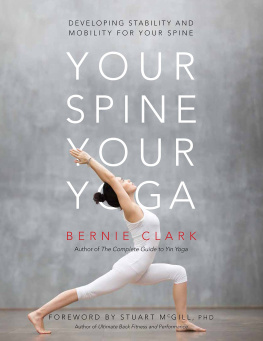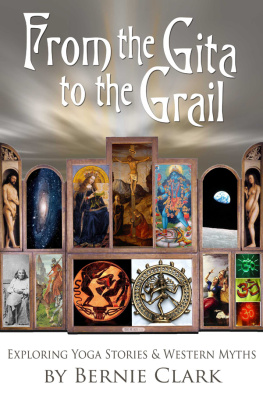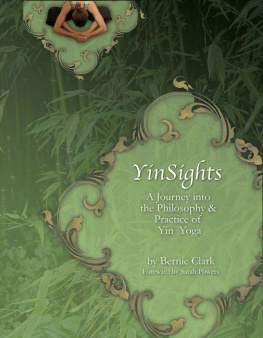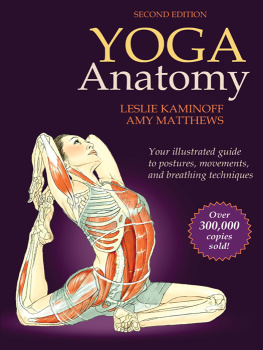Bernie Clark - Your Spine, Your Yoga
Here you can read online Bernie Clark - Your Spine, Your Yoga full text of the book (entire story) in english for free. Download pdf and epub, get meaning, cover and reviews about this ebook. year: 2018, publisher: Wild Strawberry Productions, genre: Religion. Description of the work, (preface) as well as reviews are available. Best literature library LitArk.com created for fans of good reading and offers a wide selection of genres:
Romance novel
Science fiction
Adventure
Detective
Science
History
Home and family
Prose
Art
Politics
Computer
Non-fiction
Religion
Business
Children
Humor
Choose a favorite category and find really read worthwhile books. Enjoy immersion in the world of imagination, feel the emotions of the characters or learn something new for yourself, make an fascinating discovery.
- Book:Your Spine, Your Yoga
- Author:
- Publisher:Wild Strawberry Productions
- Genre:
- Year:2018
- Rating:3 / 5
- Favourites:Add to favourites
- Your mark:
- 60
- 1
- 2
- 3
- 4
- 5
Your Spine, Your Yoga: summary, description and annotation
We offer to read an annotation, description, summary or preface (depends on what the author of the book "Your Spine, Your Yoga" wrote himself). If you haven't found the necessary information about the book — write in the comments, we will try to find it.
Your Spine, Your Yoga — read online for free the complete book (whole text) full work
Below is the text of the book, divided by pages. System saving the place of the last page read, allows you to conveniently read the book "Your Spine, Your Yoga" online for free, without having to search again every time where you left off. Put a bookmark, and you can go to the page where you finished reading at any time.
Font size:
Interval:
Bookmark:
To the women who touched me and taught me:
shakti mhi who taught me yoga
Shiva Rae who taught me movement
Sarah Powers who taught me stillness
Diana Batts who taught me kindness
Creating a book is never a solitary endeavor: a tribe is necessary, with respected elders offering the wisdom of their years, youthful muses generating energy and new points of view, as well as friends and partners contributing encouragement during the long hours of doubt. Through their grace, something worthwhile hopefully emerges. Grace and gratitude go hand in hand, and it is with tremendous gratitude that I thank the tribe that has supported me throughout the birthing of this book.
First and foremost, my gratitude goes to Paul Grilley. As I said in the dedication to the first book of this series, this is really his book! Pauls patience and guidance more than once kept me on solid ground. While I know that if he had written this book, it would have been much easier to understandshorter, clearer and more succinctI have done my best to share with readers things that fascinate me. For this reason, the book sometimes goes into detail far beyond the interest of the average yoga student, but I was often reluctant to discard teachings that I found personally fascinating. Paul kept me focused on the real intent of the book and suggested putting the nitty-gritty detail into separate appendices that can be accessed online by those who really want to go that deep. To Paul, I am grateful.
My gratitude extends to Stuart McGill, who taught me so much about how to care for and protect the spine, through his books, videos, email exchanges, Skype sessions and personal chats. His knowledge is vast, and his experience in dealing with many different bodies and how they require different ways to regain and maintain optimal spinal health helped me to qualify the advice offered in this book. His teachings changed the way I practice yoga and how I teach it. No longer do I seek mobility and enhanced ranges of motion at any cost. Today, I focus on building stability first and foremost, and only when this stability has been developed do I then focus on developing or maintaining a functional range of motion. This view of the spine is quite at odds with the prevailing stance in many yoga studios that mobility is the be-all and end-all of asana practice. I hope that I have shared Stuarts wisdom in a way that will motivate yoga teachers and students to revise their intentions. The spine is designed primarily for stability and secondarily for mobility. To Stuart, I am grateful.
My pranams and bows to the many reviewers and editors who helped to craft the rough drafts into an accessible compendium of knowledge and guidance for spinal health. Timothy McCall devoted countless hours while on a retreat in India, reading and commenting on every page. His advice kept me from narrowing my view too much and too often, and from making broad generalizations that were inappropriate and unjustified. My gratitude extends to Afrooz Afghani, who as a science editor looked over the earliest version of the book. I bow to Leslie Kaminoff for his help in honing the section on the thoracic segment and breathing. I bow also to Dania Sheldon, who did the work that I could never do: of looking over every word, caption and footnote to ensure I said what I meant. Her keen eye and tireless editing caught many errors and cleaned up much garbled writing. This is beside the welcome help she provided in sourcing permissions for many of the quotations and images shared in the book. To Stuart, Leslie and Dania, I am grateful.
Laying out a book requires the artistic hands of a designer, and once again, I bow to Alex Hennig for her support, creativity and attention to detail. She designed the cover as well as the interior layout of the book. Morgan Jeske created hundreds of drawings illustrating concepts and postures; his skill in rendering my rough sketches and translating my scribbled notes makes this book so much more digestible. Once again, Pilar Wyman created a detailed and thorough index, which makes this book more usable. And after all is said and done, every book still retains a few gotchaserrors that slip past the best reviewers. It was up to Tania Cheffins to catch those and make the finishing touches to the book as a whole. To Alex, Morgan, Pilar and Tania, I am grateful.
Finally, without the audience there is no show, and without the reader there is no book. In my mind, you are with me always. As I write, I think of you. Every writer doesthere is an audience in our heads that reviews, laughs, cries, looks confused or bored, becomes agitated or delighted by what we are typing. The great danger for any writer is to not know their audience, to create something that will interest everybody and in the process interests nobody. In my mind, yoga students and teachers who share my fascination with anatomy and practice, with biomechanics and human variation, who love details but also want to see the big picture, who want references but also want to avoid dogmatic assertionsthese were my constant companions. For all of you reading this, I am grateful.
You are holding in your hands the third volume of the Your Body, Your Yoga series, which forms the second book of the trilogy. Volume 1, What Stops Me? Sources of Tension and Compression, and Volume 2, The Lower Body, are found in the first book. The third book will include Volume 4, The Upper Body, and Volume 5, Asymmetries and Proportions. The overall format of each book is broadly similar, but there are a few differences between them.
In this volume, I am continuing the approach of separating the body into discrete segments. This is for purely pedagogical purposes (which is a fancy way of saying it makes it easy to teach the stuff), but of course our bodies are not made of Lego blocks that simply snap together. The body is a continuous whole, and any reductionist view of the body will naturally miss the big picture. We must keep that in mind any time we are investigating one part of the body in isolation from the rest. A living body is far more than the sum of its parts, more than simply a collection of levers, struts, ropes and cables. And we are far from fully understanding it. A biomechanical view of the human form is useful and even fascinating at times, but it is certainly not the whole story or the last word. As you read the contents of this series, please keep in mind that the biomechanical information offered hopefully will help you understand your own body better, but there are many gaps in our knowledge. Fortunately, as time passes, we are learning more and more.
With this understanding, it is still useful to look at discrete segments of our axial body that have very different roles and functions. Our look at the spinal segments will start at the floor of our core, with a chapter on the sacral complex. It is called a complex because it is much more than just the tail of the spine; the sacrum is an integrated part of the pelvis as well as the lowest part of the spine. Moving upward, the investigation takes us to the lumbar segment, then the thoracic segment, and we finish with the cervical complex, which, like the sacral complex, consists of more than the top of the spine: it includes the neck and head.
For each segment or complex, we investigate the form of the segment, including its architecture, bones, joint capsules, ligaments, fascia and muscles. Also presented are the ranges of variations of the tissues comprising the joints as well as some of the most important or interesting variations. Many yoga students, however, may choose to skip the form section and move straight to the second section, where we will look at the function of the spinal segment and the implications of this functionality in our yoga practice. This second part of each chapter looks at the sources of tension and compression that can limit movement and at how human variations can affect the possible movements and individuals ultimate ranges of motion.
Next pageFont size:
Interval:
Bookmark:
Similar books «Your Spine, Your Yoga»
Look at similar books to Your Spine, Your Yoga. We have selected literature similar in name and meaning in the hope of providing readers with more options to find new, interesting, not yet read works.
Discussion, reviews of the book Your Spine, Your Yoga and just readers' own opinions. Leave your comments, write what you think about the work, its meaning or the main characters. Specify what exactly you liked and what you didn't like, and why you think so.







